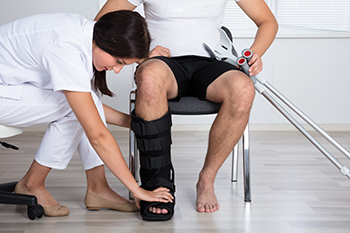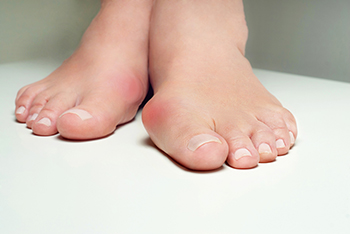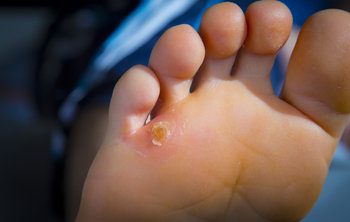Connect With Us
Blog
Items filtered by date: December 2024
What Is the Purpose of a Walking Boot?

A walking boot, also called a medical boot, is used to protect and stabilize the foot and ankle while recovering from injuries or surgery. This device supports healing by restricting unnecessary movement, which reduces the risk of additional damage. Walking boots are constructed from rigid materials, such as plastic, to immobilize the injured area, while adjustable straps ensure a secure fit. They also help redistribute body weight evenly across the foot, alleviating pressure on specific areas, including bones, tendons, and ligaments. By reducing strain, walking boots promote a more natural walking motion, allowing people to move with less pain. Common injuries that benefit from a walking boot include fractures, sprains, and tendon injuries. A podiatrist can assess the severity of your injury and determine if a walking boot is appropriate, ensuring it provides the correct level of immobilization and support for recovery. If you have sustained a foot or ankle injury, it is suggested that you schedule an appointment with a podiatrist for an exam and treatment options, which may include a walking boot.
If you are having discomfort in your feet and would like to try orthotics, contact Joan Oloff, DPM from Los Gatos Foot and Ankle . Our doctor can provide the care you need to keep you pain-free and on your feet.
What Are Orthotics?
Orthotics are inserts you can place into your shoes to help with a variety of foot problems such as flat feet or foot pain. Orthotics provide relief and comfort for minor foot and heel pain but can’t correct serious biomechanical problems in your feet.
Over-the-Counter Inserts
Orthotics come in a wide variety of over-the-counter inserts that are used to treat foot pain, heel pain, and minor problems. For example, arch supports can be inserted into your shoes to help correct overarched or flat feet, while gel insoles are often used because they provide comfort and relief from foot and heel pain by alleviating pressure.
Prescription Orthotics
If over-the-counter inserts don’t work for you or if you have a more severe foot concern, it is possible to have your podiatrist prescribe custom orthotics. These high-quality inserts are designed to treat problems such as abnormal motion, plantar fasciitis, and severe forms of heel pain. They can even be used to help patients suffering from diabetes by treating foot ulcers and painful calluses and are usually molded to your feet individually, which allows them to provide full support and comfort.
If you are experiencing minor to severe foot or heel pain, it’s recommended to speak with your podiatrist about the possibilities of using orthotics. A podiatrist can determine which type of orthotic is right for you and allow you to take the first steps towards being pain-free.
If you have any questions please contact our office located in Los Gatos, CA . We offer the newest diagnostic and treatment technologies for all your foot and ankle needs.
How to Properly Care for a Cut on the Foot

Caring for a cut on the foot is important to prevent infection and promote healing. First, clean the wound gently with mild soap and water to remove any dirt or debris. Apply a clean, sterile bandage to cover the cut and protect it from further injury or bacteria. It is essential to keep the area clean and dry to avoid complications. If the cut is deep or does not stop bleeding after applying pressure, seek attention from a podiatrist promptly. Mild antibiotic ointment can be applied to prevent infection, but be sure to change the bandage daily and monitor for signs of infection such as redness, swelling, or pus. Resting the foot and avoiding putting too much pressure on the wound can also aid in the healing process. If you have a cut on the foot or any type of foot wound, it is strongly suggested that you visit a podiatrist who can effectively treat foot wounds.
Wound care is an important part in dealing with diabetes. If you have diabetes and a foot wound or would like more information about wound care for diabetics, consult with Joan Oloff, DPM from Los Gatos Foot and Ankle . Our doctor will assess your condition and provide you with quality foot and ankle treatment.
What Is Wound Care?
Wound care is the practice of taking proper care of a wound. This can range from the smallest to the largest of wounds. While everyone can benefit from proper wound care, it is much more important for diabetics. Diabetics often suffer from poor blood circulation which causes wounds to heal much slower than they would in a non-diabetic.
What Is the Importance of Wound Care?
While it may not seem apparent with small ulcers on the foot, for diabetics, any size ulcer can become infected. Diabetics often also suffer from neuropathy, or nerve loss. This means they might not even feel when they have an ulcer on their foot. If the wound becomes severely infected, amputation may be necessary. Therefore, it is of the upmost importance to properly care for any and all foot wounds.
How to Care for Wounds
The best way to care for foot wounds is to prevent them. For diabetics, this means daily inspections of the feet for any signs of abnormalities or ulcers. It is also recommended to see a podiatrist several times a year for a foot inspection. If you do have an ulcer, run the wound under water to clear dirt from the wound; then apply antibiotic ointment to the wound and cover with a bandage. Bandages should be changed daily and keeping pressure off the wound is smart. It is advised to see a podiatrist, who can keep an eye on it.
If you have any questions, please feel free to contact our office located in Los Gatos, CA . We offer the newest diagnostic and treatment technologies for all your foot care needs.
Why Live with Pain and Numbness in Your Feet?
Stretching Away Bunion Pain

Bunions can be uncomfortable and frustrating, but stretching offers a simple way to ease discomfort and promote foot health. Regular stretches can reduce tension surrounding the big toe joint, slowing bunion progression and relieving pressure on the metatarsophalangeal joints. Strengthening foot and toe muscles through stretches improves stability and reduces strain on the affected area. Toe pulls, where you gently pull your big toe away from the second toe to encourage alignment, and toe splays, spreading your toes wide to increase flexibility, are particularly effective. These exercises improve joint mobility and alleviate daily pain caused by bunions. While stretching can help, bunions often require individualized care. If you are having persistent bunion pain or the bunion is increasing in size, it is suggested that you visit a podiatrist for tailored advice and treatment.
If you are suffering from bunion pain, contact Joan Oloff, DPM of Los Gatos Foot and Ankle . Our doctor can provide the care you need to keep you pain-free and on your feet.
What Is a Bunion?
Bunions are painful bony bumps that usually develop on the inside of the foot at the joint of the big toe. As the deformity increases over time, it may become painful to walk and wear shoes. Women are more likely to exacerbate existing bunions since they often wear tight, narrow shoes that shift their toes together. Bunion pain can be relieved by wearing wider shoes with enough room for the toes.
Causes
- Genetics – some people inherit feet that are more prone to bunion development
- Inflammatory Conditions - rheumatoid arthritis and polio may cause bunion development
Symptoms
- Redness and inflammation
- Pain and tenderness
- Callus or corns on the bump
- Restricted motion in the big toe
In order to diagnose your bunion, your podiatrist may ask about your medical history, symptoms, and general health. Your doctor might also order an x-ray to take a closer look at your feet. Nonsurgical treatment options include orthotics, padding, icing, changes in footwear, and medication. If nonsurgical treatments don’t alleviate your bunion pain, surgery may be necessary.
If you have any questions, please feel free to contact our office located in Los Gatos, CA . We offer the newest diagnostic and treatment technologies for all your foot care needs.
Preventing and Managing Foot Injuries in Rock Climbers

Rock climbers are prone to specific foot injuries due to the intense demands and unique movements required in climbing. Common injuries include toe fractures, sesamoiditis, plantar fasciitis, and metatarsalgia. The cramped position of toes in tight climbing shoes, combined with pressure against the rock, can lead to fractures and joint inflammation. Repeated high-stress landings and twisting motions may strain the plantar fascia, leading to painful plantar fasciitis, while the pressure on the ball of the foot can cause metatarsalgia. Preventing foot injuries involves choosing properly fitted climbing shoes with a balance of support and flexibility, avoiding prolonged wear, and incorporating foot-strengthening exercises. Stretching before and after climbing also helps to keep tendons and muscles resilient. If pain persists or limits climbing activities, it is suggested that you visit a podiatrist for customized advice, orthotics, or treatment options to maintain foot health.
Sports related foot and ankle injuries require proper treatment before players can go back to their regular routines. For more information, contact Joan Oloff, DPM of Los Gatos Foot and Ankle . Our doctor can provide the care you need to keep you pain-free and on your feet.
Sports Related Foot and Ankle Injuries
Foot and ankle injuries are a common occurrence when it comes to athletes of any sport. While many athletes dismiss the initial aches and pains, the truth is that ignoring potential foot and ankle injuries can lead to serious problems. As athletes continue to place pressure and strain the area further, a mild injury can turn into something as serious as a rupture and may lead to a permanent disability. There are many factors that contribute to sports related foot and ankle injuries, which include failure to warm up properly, not providing support or wearing bad footwear. Common injuries and conditions athletes face, including:
- Plantar Fasciitis
- Plantar Fasciosis
- Achilles Tendinitis
- Achilles Tendon Rupture
- Ankle Sprains
Sports related injuries are commonly treated using the RICE method. This includes rest, applying ice to the injured area, compression and elevating the ankle. More serious sprains and injuries may require surgery, which could include arthroscopic and reconstructive surgery. Rehabilitation and therapy may also be required in order to get any recovering athlete to become fully functional again. Any unusual aches and pains an athlete sustains must be evaluated by a licensed, reputable medical professional.
If you have any questions please feel free to contact our office located in Los Gatos, CA . We offer the newest diagnostic and treatment technologies for all your foot and ankle needs.
Understanding Corn Formation

Corns are thickened, hardened areas of skin that typically develop on the feet, often causing discomfort and pain. These formations occur as a response to repeated friction or pressure, usually from wearing ill-fitting shoes or abnormal foot mechanics. There are two main types of corns. Hard corns are small, round, and found on the tops or sides of toes, and soft corns are white and rubbery, often found between the toes. The primary cause of corns is consistent rubbing or pressure, which triggers the skin to harden as a protective response. Symptoms include localized pain, tenderness, and the visible buildup of thickened skin. Corns can lead to further complications if left untreated, including infection or difficulty walking. Corns can cause severe pain, and it may be difficult to complete daily activities. If you have a painful corn, it is suggested that you consult a podiatrist who can offer you effective relief tips.
Corns can make walking very painful and should be treated immediately. If you have questions regarding your feet and ankles, contact Joan Oloff, DPM of Los Gatos Foot and Ankle . Our doctor will treat your foot and ankle needs.
Corns: What Are They? And How Do You Get Rid of Them?
Corns are thickened areas on the skin that can become painful. They are caused by excessive pressure and friction on the skin. Corns press into the deeper layers of the skin and are usually round in shape.
Ways to Prevent Corns
There are many ways to get rid of painful corns such as:
- Wearing properly fitting shoes that have been measured by a professional
- Wearing shoes that are not sharply pointed or have high heels
- Wearing only shoes that offer support
Treating Corns
Although most corns slowly disappear when the friction or pressure stops, this isn’t always the case. Consult with your podiatrist to determine the best treatment option for your case of corns.
If you have any questions please feel free to contact our office located in Los Gatos, CA . We offer the newest diagnostic and treatment technologies for all your foot and ankle needs.

